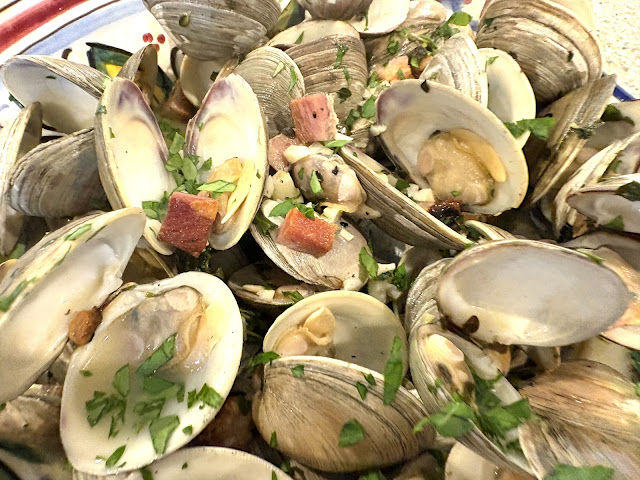It's summertime and that means no-fuss, no-muss cooking. These clams, cooked in a disposable pan on the grill, fit the bill perfectly. We ate them as our main course, sharing a little more than forty clams, but enough to serve as an appetizer for a larger group. I was inspired to make these after reading about how much protein we "seniors" should be eating each day. A 70-year-old woman generally needs between 1.0 and 1.2 grams of protein per day for each kilogram of body weight. That's higher than the recommended intake for younger adults and is crucial for maintaining muscle mass, bone strength, and overall health. For example, a 150-pound (68 kg) woman would need approximately 68-82 grams of protein daily. When I checked how much food I needed to eat to consume that amount of protein, I realized I needed to
up my game. We eat mostly fish, chicken or a grain main course, like pasta, and eat red meat only once or twice a month at most. Oatmeal is our breakfast of choice, but we'll be rotating that with yogurt or eggs from now on. When I looked up the amount of protein in clams, I was astonished to learn that 12 littleneck clams contain 22-28 grams of protein, meaning that my meal last night contained half if not more of my protein requirements for the day. Yea! Clams are also rich in vitamins and minerals and low in fat and calories. Win-win! The small amount of pancetta added even more protein and added more flavor. Are you on board? Start by drizzling a little olive oil in a disposable pan, and place the pancetta inside. Place the grill on high heat and cook the pancetta until it's crisp and the fat has been rendered.
Add the clams and the rest of the ingredients -- a little knob of butter, dry white wine, garlic, salt, and fresh herbs.
Close the lid and let it bubble away for five minutes, then open the lid and stir to move the clams around. I also added more fresh herbs each time I opened the lid of the grill.
Cook for ten to fifteen minutes, or until the clams have all opened and had a chance to cook through. Toss more fresh parsley on top and serve with grilled bread that's been moistened with olive oil and sprinkled with coarse sea salt.
Click here to connect with me on Instagram and find out what’s cooking in Ciao Chow Linda’s kitchen each day (and more)Clams On The Grill
1 bag of littleneck clams (there were about 40 in the bag)
1 slice of pancetta 1/2" thick, cut into small pieces
2 tablespoons olive oil
2 tablespoons butter
six cloves of minced garlic
1/4 cup dry white wine
salt
minced parsley, plus other herbs to your liking (I used sprigs of thyme and marjoram)
Place the olive oil and pancetta in the disposable pan and cook over high heat until the pancetta loses its fat and starts to crisp. Add the clams, the garlic, salt, wine, butter and herbs, leaving some minced parsley to sprinkle over the top at the end.
Cover the lid of the grill, opening the lid occasionally to stir once or twice. When the clams are all open and have cooked for a few minutes, they are done. It may take 10 to fifteen or twenty minutes.
Serve with grilled bread, smeared with olive oil and salt.





